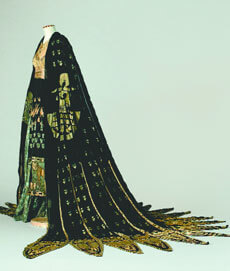AXA exhibit reveals genius of cinema’s unrecognized costumers
In the 1960s and 70s, film enthusiasts were besotted with the auteur theory, which originated in France, and basically promulgated the idea of the director being the major artistic force behind any film. Derided, even totally neglected movies were reconsidered as masterpieces and John Ford, Alfred Hitchcock, and Josef von Sternberg were elevated to godly ranks, at the expense of the writers, technicians, and designers who were at times equally responsible for the quality of these films.
Currently, the world is awash in the visual, and obsessed with fashion on every level. Perhaps, therefore, it’s time to promote the notion of the costume designer as auteur. They are artists who have typically been deprived of even simple recognition; New York Times’ film reviews, for example, do not even cite them.
Considering how dearly cherished is the legacy of Hollywood’s Golden Age only underscores the contribution of those costumers whose input immortalized generations of iconic personalities.
What would “Gone with the Wind” be like, without Walter Plunkett’s unforgettable gowns for Scarlett O’Hara? Her ante-bellum crinolines, the green dress she makes from her mother’s curtains (which Carol Burnett comically immortalized), the red velvet slut-wear Rhett Butler forces her into at her moment of atonement are an indelible part of what makes that movie an enduring guilty pleasure. Can you imagine a “Wizard of Oz” without Adrian’s genius, from those ruby slippers to all that fantastic detail on those Munchkins or Glinda, glittering away (and completely ripped off for Broadway’s “Wicked”)?
When it comes to flops of the studio era, the costumes alone often afford the only real viewing interest. These ace designers made the female stars of the era into living works of art. Indefatigable style-setter Joan Crawford was named box office poison because of the lousy MGM scripts she was given, but even in dross like “I Live My Life” or “The Bride Wore Red,” Adrian made every entrance an adventure, whether it was the awesome silver lamé gown with sleeves like sails, which Adrian dubbed “The Bounty,” for the former, or the miraculous red-beaded sheath he did for the latter.
The same goes for every other studio: at Warner Brothers, the brilliant Orry-Kelly made Kay Francis into the best-dressed woman on the screen in an endless series of turgid soap operas, while at Fox, Gwen Wakeling and Royer helped Loretta Young waltz through myriad doorways, always looking flawless, regardless of how inane the premise. Bernard Newman, responsible for Ginger Rogers’gowns in her Fred Astaire movies, is the true auteur of “Break of Hearts” (1935). A real sudsy number of womanly self-sacrifice, it nonetheless features Katharine Hepburn, proving that she could wear anything with her model’s body in a breathtakingly daring series of ensembles. (This ain’t no typically tailored, concierge-coiffed Kate we’re taking about here.) The inspiration and workmanship of these costumes continue to dazzle and influence to this day, preserved for eternity on film.
Crawford’s “Bride Wore Red” masterpiece still exists, beautifully preserved in the Fashion Institute of Technology, which brings up the costume efforts of another institution. “CUT! Costume for the Silver Screen” is the name of the exquisite exhibit now at AXA Gallery, culled from the vast, pioneering costume collection of Paris’ Cinematheque Francaise. Many of the garments shown were once exhibited in the Cinematheque’s Henri Langlois Cinema Museum, which sadly closed in 1997, so New York is fortunate, indeed, to have the chance to see them now.
While it is a celebration of film frocks, the exhibit incidentally also celebrates the many gay men, of seemingly inexhaustible imagination, who designed them. That master fantasist Adrian is, of course, represented, by a moss velvet Empire gown which matched Greta Garbo’s statuesque line in “Conquest,” and a bespangled tulle monstrosity—admittedly not one of his better efforts—for Kathryn Grayson in “Lovely to Look At.”
While MGM had Adrian, Paramount (and later Fox) had the brilliant, alcoholic Travis Banton, perhaps the greatest designer of them all. It was he who engineered the lush looks that made Marlene Dietrich a goddess in the films of Josef von Sternberg, while Carole Lombard, Claudette Colbert, Louise Brooks, and Mae West also owed their fashion icon status to him. A diaphanous flapper sheath Banton made for Clara Bow lies in a case, silently evoking the Roaring 20s as well as the shimmering sensuality that was the designer’s trademark.
Plunkett was known as the best period designer in the business, evinced by a Scarlett O’Hara gown, one for Elizabeth Taylor’s Amy in “Little Women,” and a beaded fringe flapper number for Jean Hagen’s immortal, vocally challenged Lina Lamont in “Singin’ in the Rain.” Another period master, Cecil Beaton, an Oscar-winner for “Gigi,” has his white satin “Maxim”’s gown worn by Leslie Caron on display, although it was hideously altered for a later film. (Such desecration was often sadly typical of studio economics, which never stinted from recycling even the most revered costumes for later productions.) The black sparrows, which originally served as the gown’s only trimming, are now gone, but it should be known that they were the inspiration of Caron, not Beaton. When she saw his cursory sketch for the scene, she exclaimed with delight about the bows he had indicated, thinking that they were birds, instead. “No, these are knots,” he replied. “I envisioned them in velvet, but if you want sparrows, we’ll make it sparrows.”
Mitchell Leisen was a talented, gay designer for Cecil B. DeMille who, like Vincente Minnelli after him, left costuming to become a highly stylish director in his own right (“Midnight,” “Easy Living”). He and Adrian collaborated on the deliciously stylized Renaissance silver lamé wedding gown for Mary Pickford in her early talkie, “The Taming of the Shrew.” Leisen later hired Tony Award-winning designer Willa Kim, a rare survivor of the studio era, to work on “Lady in the Dark,” a major fashion film of 1944.
“I’d been a student at Chouinard,” Kim recalled as we walked through the exhibit through together, “and Mitch had seen some illustrations I’d done for the May Company. I originally wanted to be an artist, but this is how I fell into costume design. Leisen was such a good designer, especially for DeMille. I’m convinced those gorgeous gowns for Claudette Colbert’s ‘Cleopatra’ were really his, and not Travis Banton’s. He put me to work with Raoul Pene DuBois, whom I later assisted on Broadway. They had me work on the patterns for the famous mink dress that Ginger Rogers wore, which Mitch designed.”
Edith Head also worked on the film and, as she so often did, later took credit for that design. Her work is conspicuously absent from the exhibit, which is just as well. More of a studio strategist than a real designer, Head managed to survive longer than anyone else in this toughest of industries (capturing eight Oscars) through no-nonsense competency, politicking executives, and currying star favors rather than from any design genius.
“She was very nice to me, but I remember I had a couple of suits someone ran up for me, and she stole their designs for a film,” Kim said.
Kim also went for an interview at Adrian’s salon, and remembered meeting another legendary designer, Irene Sharaff, in the parking lot.
“She was very eager to meet me, because she liked Asian girls,” Kim recalled with a chuckle. “She had a girlfriend named Mei-Mei, who was very nasty to me one night we were all having dinner together. She kept picking on me, until Irene told her to stop it.”
An elaborately embroidered chiffon cape for Marlene Dietrich’s turkey, “Kismet,” was designed by MGM’s Irene, but executed by Madame Karinska, the greatest technician of her day. When any designer of the day wanted their sketches done right, they always took them to Karinska’s studio, where inspirational gaps were also often filled in. Kim also worked with her, and the talented designer Tom Keogh, whose work is too little known today. “He told me, originally, Marlene’s famous legs were to be covered in tiny gold chains, but the fittings were torturous with her,” Kim recalled. “She was such a perfectionist, worrying over the length of every single little chain, that they eventually just painted her legs gold instead.”
The great film fantasy, “Beauty and the Beast” (1946), was a true summit meeting of gay talent, with Jean Cocteau directing and writing, his lover Jean Marais starring, and the fabulously talented, opium-smoking Christian Berard on design. A gown from that film displays the straw trim, which was used in lieu of real braided fabric, due to postwar financial exigencies.
More up-to-date items in the show include gowns by Karl Lagerfeld and Yves St. Laurent, which represent the later, more reality-based, fashion-influenced costuming which is prevalent today. Lagerfeld’s cut-out sheath for the impossibly elegant Stephane Audran in Luis Bunuel’s “The Discreet Charm of the Bourgeoisie” (1972) could be worn today without a blink. The feather-trimmed ensemble by St. Laurent for Annie Duperey in “Stavisky” suggests 1974 as much as it does the early 1930s.
The studio system as it was once known may be long dead, along with the designers who created its powerful glamour, but their work miraculously survives in venues such as this exhibit, on Turner Classic Movies, and even more spectacularly in big screen theatrical revivals around the world.


































